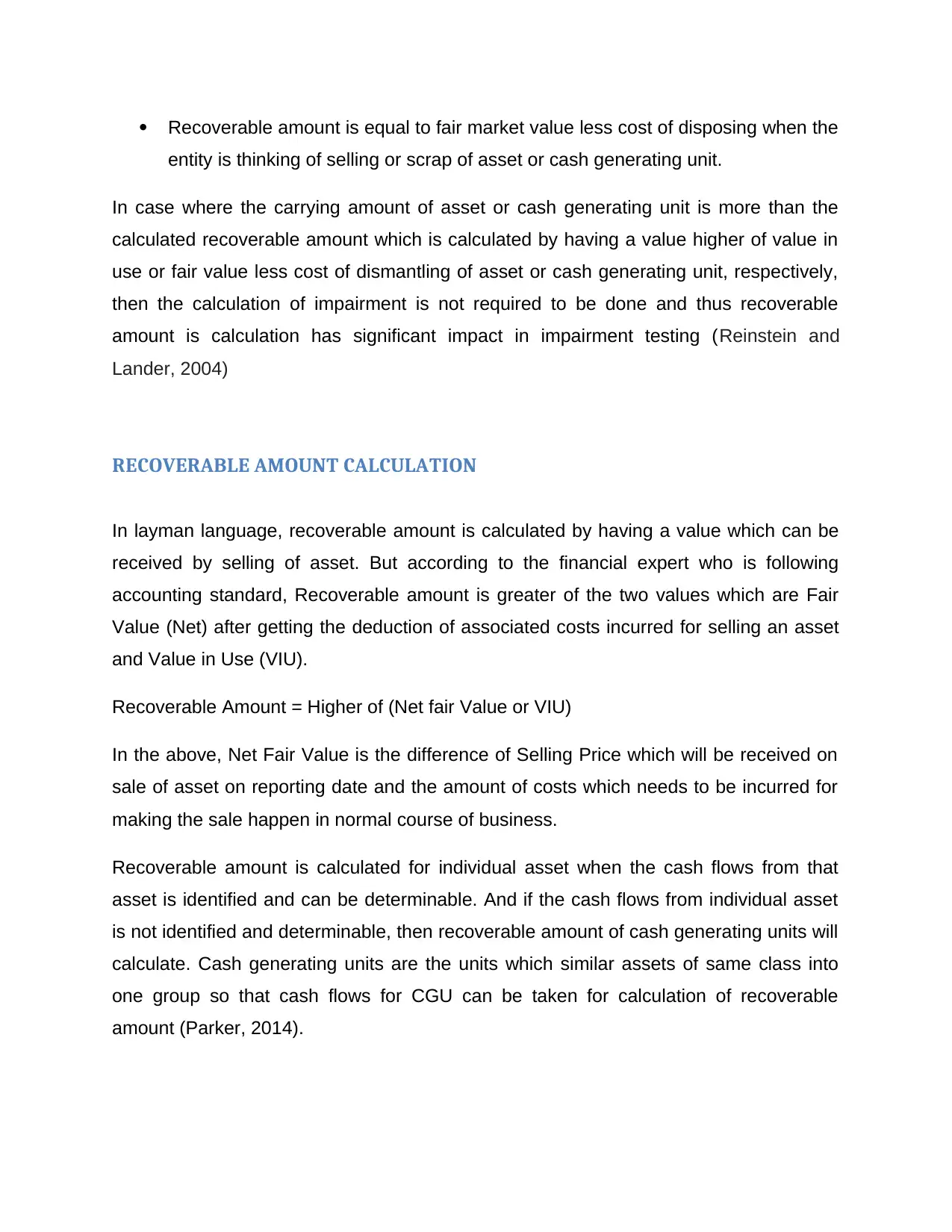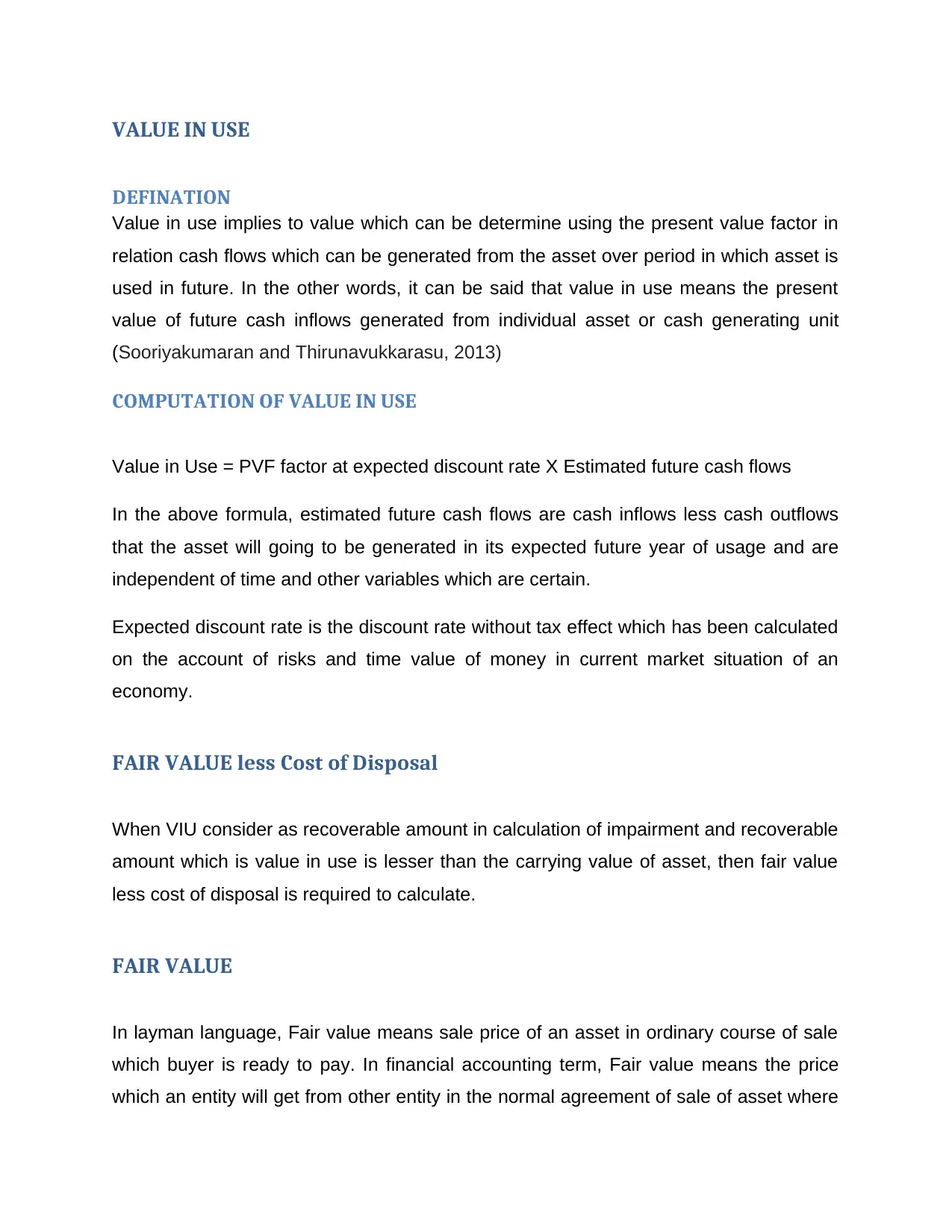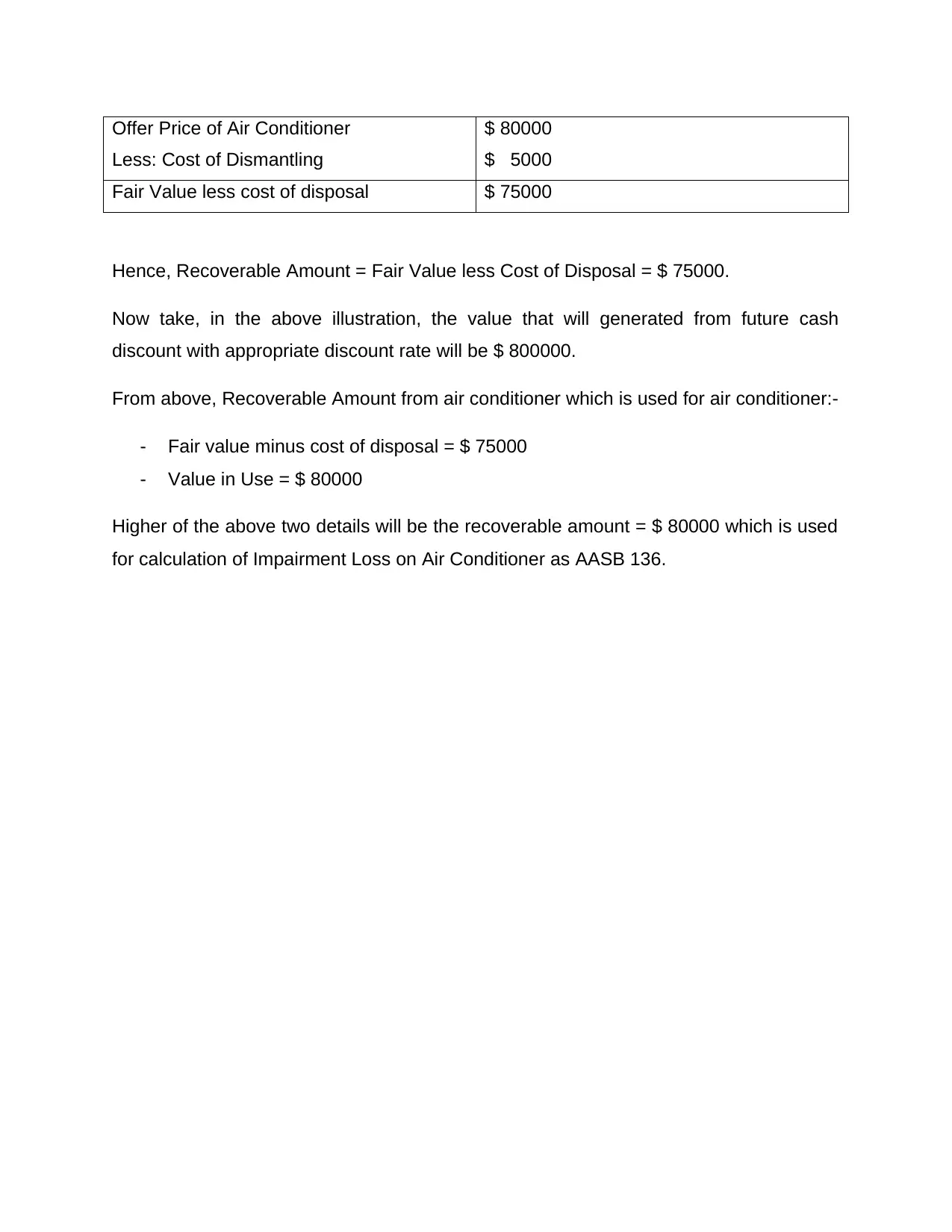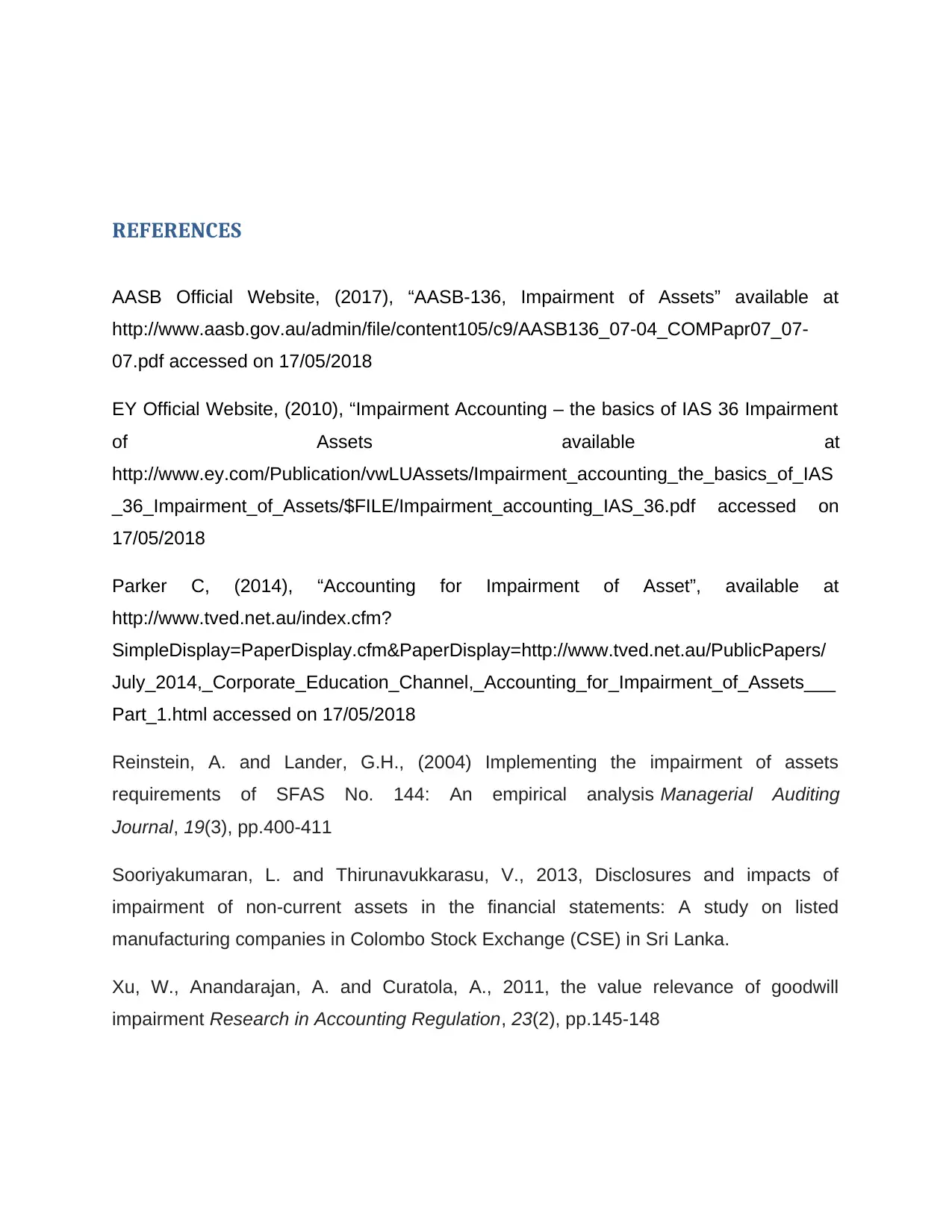Comprehensive Report on Recoverable Amount Analysis - IAS 36/AASB 136
VerifiedAdded on 2023/06/12
|6
|1412
|426
Report
AI Summary
This report provides a detailed analysis of the concept of recoverable amount as defined under IAS 36 and AASB 136, which deal with the impairment of assets. It explains the significance of determining the recoverable amount for appropriately valuing non-current assets in financial statements. The report elaborates on how recoverable amount is calculated, emphasizing its role in impairment testing. It distinguishes between value in use (VIU) and fair value less cost of disposal, providing formulas and illustrations for calculating each. The document further explains fair value and cost of disposal, offering a practical example to demonstrate the calculation of net fair value and recoverable amount, highlighting the importance of these calculations in assessing impairment loss as per AASB 136. The report references relevant accounting standards and websites to support its analysis.

PART A
ANALYSIS OF AMOUNT RECOVERABLE
According to IAS 36/ AASB 136 which deal with Impairment of Assets, an entity having
Non Current Assets has to find out recoverable amount which is calculated as per
concepts laid in AASB.
SIGNIFICANCE
For showing the value of noncurrent asset appropriately in books of account of an
entity, impairment loss is calculated as per AASB 136. Recoverable amount is one
parameter for calculation of impairment loss which implies used value in current
available with entity and its management or fair market value less cost of making the
asset scrap, whichever is higher among the two (AASB, 2017).
EXPLANATION
As per the guidelines available for Impairment of Asset, Every entity needs to disclose
all the individual assets and cash generating units whose carrying amount is less than
the market value fetch by the asset or cash generating units in an ordinary course of
business. Accordingly, if there is situation of having less fair value than value shown in
books of an asset or cash generating unit by an entity, then calculation of recoverable
amount is must for evaluating the amount of impairment on Asset or CGU. Recoverable
amount is calculated like value calculated for inventory that is cost or net realizable
value, whichever is lower. As per rules defined in AASB 136:-
Recoverable amount is equal to value in use, the fair value less cost of disposing
of assets is not establish by an entity or its management
ANALYSIS OF AMOUNT RECOVERABLE
According to IAS 36/ AASB 136 which deal with Impairment of Assets, an entity having
Non Current Assets has to find out recoverable amount which is calculated as per
concepts laid in AASB.
SIGNIFICANCE
For showing the value of noncurrent asset appropriately in books of account of an
entity, impairment loss is calculated as per AASB 136. Recoverable amount is one
parameter for calculation of impairment loss which implies used value in current
available with entity and its management or fair market value less cost of making the
asset scrap, whichever is higher among the two (AASB, 2017).
EXPLANATION
As per the guidelines available for Impairment of Asset, Every entity needs to disclose
all the individual assets and cash generating units whose carrying amount is less than
the market value fetch by the asset or cash generating units in an ordinary course of
business. Accordingly, if there is situation of having less fair value than value shown in
books of an asset or cash generating unit by an entity, then calculation of recoverable
amount is must for evaluating the amount of impairment on Asset or CGU. Recoverable
amount is calculated like value calculated for inventory that is cost or net realizable
value, whichever is lower. As per rules defined in AASB 136:-
Recoverable amount is equal to value in use, the fair value less cost of disposing
of assets is not establish by an entity or its management
Paraphrase This Document
Need a fresh take? Get an instant paraphrase of this document with our AI Paraphraser

Recoverable amount is equal to fair market value less cost of disposing when the
entity is thinking of selling or scrap of asset or cash generating unit.
In case where the carrying amount of asset or cash generating unit is more than the
calculated recoverable amount which is calculated by having a value higher of value in
use or fair value less cost of dismantling of asset or cash generating unit, respectively,
then the calculation of impairment is not required to be done and thus recoverable
amount is calculation has significant impact in impairment testing (Reinstein and
Lander, 2004)
RECOVERABLE AMOUNT CALCULATION
In layman language, recoverable amount is calculated by having a value which can be
received by selling of asset. But according to the financial expert who is following
accounting standard, Recoverable amount is greater of the two values which are Fair
Value (Net) after getting the deduction of associated costs incurred for selling an asset
and Value in Use (VIU).
Recoverable Amount = Higher of (Net fair Value or VIU)
In the above, Net Fair Value is the difference of Selling Price which will be received on
sale of asset on reporting date and the amount of costs which needs to be incurred for
making the sale happen in normal course of business.
Recoverable amount is calculated for individual asset when the cash flows from that
asset is identified and can be determinable. And if the cash flows from individual asset
is not identified and determinable, then recoverable amount of cash generating units will
calculate. Cash generating units are the units which similar assets of same class into
one group so that cash flows for CGU can be taken for calculation of recoverable
amount (Parker, 2014).
entity is thinking of selling or scrap of asset or cash generating unit.
In case where the carrying amount of asset or cash generating unit is more than the
calculated recoverable amount which is calculated by having a value higher of value in
use or fair value less cost of dismantling of asset or cash generating unit, respectively,
then the calculation of impairment is not required to be done and thus recoverable
amount is calculation has significant impact in impairment testing (Reinstein and
Lander, 2004)
RECOVERABLE AMOUNT CALCULATION
In layman language, recoverable amount is calculated by having a value which can be
received by selling of asset. But according to the financial expert who is following
accounting standard, Recoverable amount is greater of the two values which are Fair
Value (Net) after getting the deduction of associated costs incurred for selling an asset
and Value in Use (VIU).
Recoverable Amount = Higher of (Net fair Value or VIU)
In the above, Net Fair Value is the difference of Selling Price which will be received on
sale of asset on reporting date and the amount of costs which needs to be incurred for
making the sale happen in normal course of business.
Recoverable amount is calculated for individual asset when the cash flows from that
asset is identified and can be determinable. And if the cash flows from individual asset
is not identified and determinable, then recoverable amount of cash generating units will
calculate. Cash generating units are the units which similar assets of same class into
one group so that cash flows for CGU can be taken for calculation of recoverable
amount (Parker, 2014).

VALUE IN USE
DEFINATION
Value in use implies to value which can be determine using the present value factor in
relation cash flows which can be generated from the asset over period in which asset is
used in future. In the other words, it can be said that value in use means the present
value of future cash inflows generated from individual asset or cash generating unit
(Sooriyakumaran and Thirunavukkarasu, 2013)
COMPUTATION OF VALUE IN USE
Value in Use = PVF factor at expected discount rate X Estimated future cash flows
In the above formula, estimated future cash flows are cash inflows less cash outflows
that the asset will going to be generated in its expected future year of usage and are
independent of time and other variables which are certain.
Expected discount rate is the discount rate without tax effect which has been calculated
on the account of risks and time value of money in current market situation of an
economy.
FAIR VALUE less Cost of Disposal
When VIU consider as recoverable amount in calculation of impairment and recoverable
amount which is value in use is lesser than the carrying value of asset, then fair value
less cost of disposal is required to calculate.
FAIR VALUE
In layman language, Fair value means sale price of an asset in ordinary course of sale
which buyer is ready to pay. In financial accounting term, Fair value means the price
which an entity will get from other entity in the normal agreement of sale of asset where
DEFINATION
Value in use implies to value which can be determine using the present value factor in
relation cash flows which can be generated from the asset over period in which asset is
used in future. In the other words, it can be said that value in use means the present
value of future cash inflows generated from individual asset or cash generating unit
(Sooriyakumaran and Thirunavukkarasu, 2013)
COMPUTATION OF VALUE IN USE
Value in Use = PVF factor at expected discount rate X Estimated future cash flows
In the above formula, estimated future cash flows are cash inflows less cash outflows
that the asset will going to be generated in its expected future year of usage and are
independent of time and other variables which are certain.
Expected discount rate is the discount rate without tax effect which has been calculated
on the account of risks and time value of money in current market situation of an
economy.
FAIR VALUE less Cost of Disposal
When VIU consider as recoverable amount in calculation of impairment and recoverable
amount which is value in use is lesser than the carrying value of asset, then fair value
less cost of disposal is required to calculate.
FAIR VALUE
In layman language, Fair value means sale price of an asset in ordinary course of sale
which buyer is ready to pay. In financial accounting term, Fair value means the price
which an entity will get from other entity in the normal agreement of sale of asset where
⊘ This is a preview!⊘
Do you want full access?
Subscribe today to unlock all pages.

Trusted by 1+ million students worldwide

buyer and seller to agreement knows every term and conditions required to be fulfilled
for the sale of the asset. As per IFRS principles, in impairment, fair value will be
calculated on a particular date called reporting date (Xu, Anandarajan and Curatola,
2011)
COST OF DISPOSAL
It is an amount or cost which is needed and required to paid or incurred to create the
situation of sale of an asset. It is an associated cost which is out of control and that are
necessarily incurred to have the sale of an asset to be done at fair value.
CALCULATION OF NET FAIR VALUE
We can calculate Fair Value less cost of dismantling of asset as under:-
Fair Value Xxx
Minus: Dismantling Cost (xxx)
Net Fair Value Xxx
Where market price of the specific assent or cash generating units is not available, then
fair value less cost of disposal of asset or CGU will calculated using discounted cash
flow approach
ILLUSTRATION
X Ltd had acquired air conditioner worth $ 100000 on 1st June, 2016. On 30th June,
2017, the book value of air conditioner is $ 90000. The company got offer in open for
purchase air conditioner by another party for $ 80000. The company has to spent the
amount on transportation and dismantling of air conditioner for $ 5000.
In the above example,
for the sale of the asset. As per IFRS principles, in impairment, fair value will be
calculated on a particular date called reporting date (Xu, Anandarajan and Curatola,
2011)
COST OF DISPOSAL
It is an amount or cost which is needed and required to paid or incurred to create the
situation of sale of an asset. It is an associated cost which is out of control and that are
necessarily incurred to have the sale of an asset to be done at fair value.
CALCULATION OF NET FAIR VALUE
We can calculate Fair Value less cost of dismantling of asset as under:-
Fair Value Xxx
Minus: Dismantling Cost (xxx)
Net Fair Value Xxx
Where market price of the specific assent or cash generating units is not available, then
fair value less cost of disposal of asset or CGU will calculated using discounted cash
flow approach
ILLUSTRATION
X Ltd had acquired air conditioner worth $ 100000 on 1st June, 2016. On 30th June,
2017, the book value of air conditioner is $ 90000. The company got offer in open for
purchase air conditioner by another party for $ 80000. The company has to spent the
amount on transportation and dismantling of air conditioner for $ 5000.
In the above example,
Paraphrase This Document
Need a fresh take? Get an instant paraphrase of this document with our AI Paraphraser

Offer Price of Air Conditioner $ 80000
Less: Cost of Dismantling $ 5000
Fair Value less cost of disposal $ 75000
Hence, Recoverable Amount = Fair Value less Cost of Disposal = $ 75000.
Now take, in the above illustration, the value that will generated from future cash
discount with appropriate discount rate will be $ 800000.
From above, Recoverable Amount from air conditioner which is used for air conditioner:-
- Fair value minus cost of disposal = $ 75000
- Value in Use = $ 80000
Higher of the above two details will be the recoverable amount = $ 80000 which is used
for calculation of Impairment Loss on Air Conditioner as AASB 136.
Less: Cost of Dismantling $ 5000
Fair Value less cost of disposal $ 75000
Hence, Recoverable Amount = Fair Value less Cost of Disposal = $ 75000.
Now take, in the above illustration, the value that will generated from future cash
discount with appropriate discount rate will be $ 800000.
From above, Recoverable Amount from air conditioner which is used for air conditioner:-
- Fair value minus cost of disposal = $ 75000
- Value in Use = $ 80000
Higher of the above two details will be the recoverable amount = $ 80000 which is used
for calculation of Impairment Loss on Air Conditioner as AASB 136.

REFERENCES
AASB Official Website, (2017), “AASB-136, Impairment of Assets” available at
http://www.aasb.gov.au/admin/file/content105/c9/AASB136_07-04_COMPapr07_07-
07.pdf accessed on 17/05/2018
EY Official Website, (2010), “Impairment Accounting – the basics of IAS 36 Impairment
of Assets available at
http://www.ey.com/Publication/vwLUAssets/Impairment_accounting_the_basics_of_IAS
_36_Impairment_of_Assets/$FILE/Impairment_accounting_IAS_36.pdf accessed on
17/05/2018
Parker C, (2014), “Accounting for Impairment of Asset”, available at
http://www.tved.net.au/index.cfm?
SimpleDisplay=PaperDisplay.cfm&PaperDisplay=http://www.tved.net.au/PublicPapers/
July_2014,_Corporate_Education_Channel,_Accounting_for_Impairment_of_Assets___
Part_1.html accessed on 17/05/2018
Reinstein, A. and Lander, G.H., (2004) Implementing the impairment of assets
requirements of SFAS No. 144: An empirical analysis Managerial Auditing
Journal, 19(3), pp.400-411
Sooriyakumaran, L. and Thirunavukkarasu, V., 2013, Disclosures and impacts of
impairment of non-current assets in the financial statements: A study on listed
manufacturing companies in Colombo Stock Exchange (CSE) in Sri Lanka.
Xu, W., Anandarajan, A. and Curatola, A., 2011, the value relevance of goodwill
impairment Research in Accounting Regulation, 23(2), pp.145-148
AASB Official Website, (2017), “AASB-136, Impairment of Assets” available at
http://www.aasb.gov.au/admin/file/content105/c9/AASB136_07-04_COMPapr07_07-
07.pdf accessed on 17/05/2018
EY Official Website, (2010), “Impairment Accounting – the basics of IAS 36 Impairment
of Assets available at
http://www.ey.com/Publication/vwLUAssets/Impairment_accounting_the_basics_of_IAS
_36_Impairment_of_Assets/$FILE/Impairment_accounting_IAS_36.pdf accessed on
17/05/2018
Parker C, (2014), “Accounting for Impairment of Asset”, available at
http://www.tved.net.au/index.cfm?
SimpleDisplay=PaperDisplay.cfm&PaperDisplay=http://www.tved.net.au/PublicPapers/
July_2014,_Corporate_Education_Channel,_Accounting_for_Impairment_of_Assets___
Part_1.html accessed on 17/05/2018
Reinstein, A. and Lander, G.H., (2004) Implementing the impairment of assets
requirements of SFAS No. 144: An empirical analysis Managerial Auditing
Journal, 19(3), pp.400-411
Sooriyakumaran, L. and Thirunavukkarasu, V., 2013, Disclosures and impacts of
impairment of non-current assets in the financial statements: A study on listed
manufacturing companies in Colombo Stock Exchange (CSE) in Sri Lanka.
Xu, W., Anandarajan, A. and Curatola, A., 2011, the value relevance of goodwill
impairment Research in Accounting Regulation, 23(2), pp.145-148
⊘ This is a preview!⊘
Do you want full access?
Subscribe today to unlock all pages.

Trusted by 1+ million students worldwide
1 out of 6
Related Documents
Your All-in-One AI-Powered Toolkit for Academic Success.
+13062052269
info@desklib.com
Available 24*7 on WhatsApp / Email
![[object Object]](/_next/static/media/star-bottom.7253800d.svg)
Unlock your academic potential
Copyright © 2020–2025 A2Z Services. All Rights Reserved. Developed and managed by ZUCOL.





